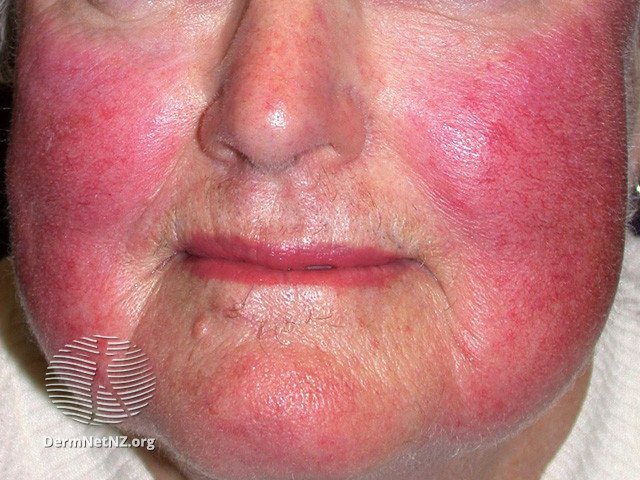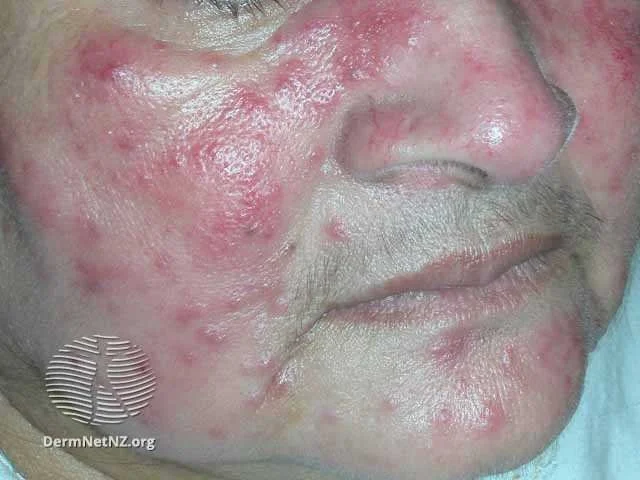
Rosacea
An example of erythrotelangiectatic rosacea, which manifests with background redness and broken blood vessels.
Credit: DermNet NZ
What is rosacea?
Rosacea is a long-term skin condition that primarily affects the face, resulting in redness, swelling, pus-filled bumps, and the appearance of small, dilated blood vessels. Typically seen on the nose, cheeks, forehead, and chin, the condition can progress, leading to a bulbous nose in some long-term sufferers. Predominantly observed in individuals with fair skin and blue eyes, rosacea often manifests between the ages of 30 and 60. Its symptoms can persist or fluctuate but won't recede without intervention.
What causes rosacea?
The exact etiology of rosacea remains elusive. However, a combination of factors, such as sun exposure, genetics, environment, vascular changes, and inflammation, are believed to contribute. There's also speculation about the role of hair follicle mites, though it's not conclusive. Several triggers can exacerbate rosacea, including:
Prolonged use of topical or oral steroids like prednisone
Extended exposure to sunlight
Consumption of hot or spicy foods
Alcohol consumption
Exposure to extreme temperatures
Emotional stress
Intense physical activity
Some medications
What are the symptoms of rosacea?
Rosacea presents as reddened areas on the face, often accompanied by pus-filled bumps. Unlike acne, it doesn't feature blackheads, whiteheads, or deep nodules. Common symptoms encompass:
Regular blushing or flushing
Visible redness and noticeable blood vessels
Red, raised spots on facial areas such as the nose, forehead, cheeks, and chin
Dry, flaky skin on the face
Sensitivity to products, accompanied by burning or stinging sensations
Eye irritation, manifesting as red or swollen eyelids, bump formation, or styes
A swollen, bulbous nose with pronounced pores
Persistent facial swelling
How do I treat rosacea?
Treatment is tailored to the individual's specific symptoms and the subtype of rosacea they have. Sun protection and sunscreen application are essential to mitigate symptom exacerbation. It's also advisable to reduce exposure to known triggers. While makeup can camouflage the redness, it's pivotal to avoid topical steroids as they can exacerbate the condition. Treatment modalities include:
Oral antibiotics, such as doxycycline
Topical metronidazole cream or gel
Azelaic acid formulations
Gels containing brimonidine or oxymetazoline hydrochloride for redness reduction
Ivermectin cream
Oral isotretinoin for severe cases
Laser therapy for vascular symptoms
How do I prevent rosacea?
While rosacea's onset can't be entirely prevented, flare-ups can be minimized:
Limit direct sun exposure and ensure sunburn prevention
Avoid trigger foods like hot, spicy dishes or alcoholic drinks
Shield the skin from extreme temperatures
Manage and mitigate stress factors
An example of rhinophyma in rosacea, which presents with dilated oil glands on the nose and general enlargement of the nose, often with a bumpy texture.
Credit: DermNet NZ
An example of papulopustular rosacea, which manifests as pimple-like bumps on the cheeks and nose, sometimes with background redness, as well as dry, burning sensations on the skin.
Credit: DermNet NZ



